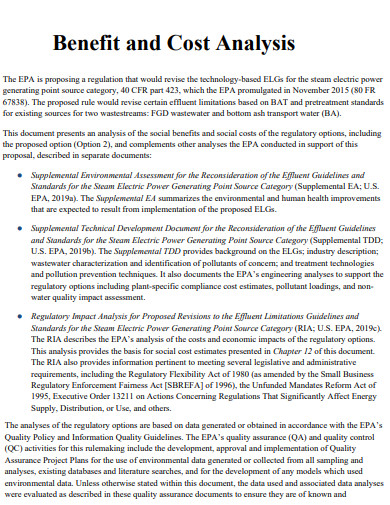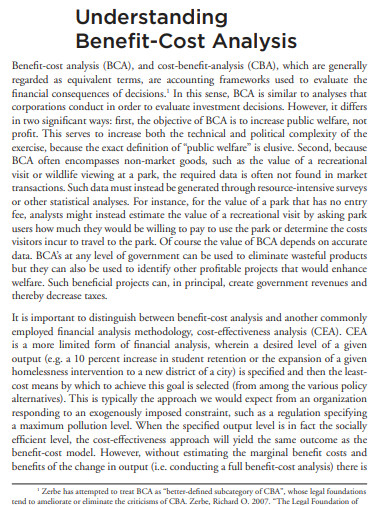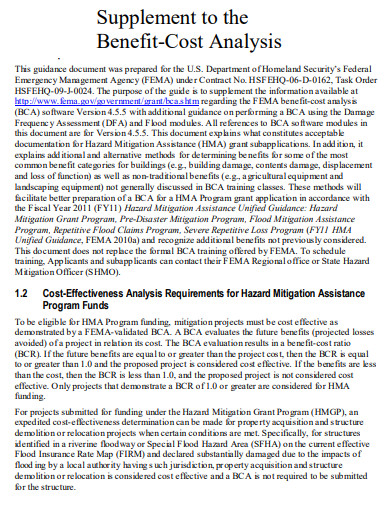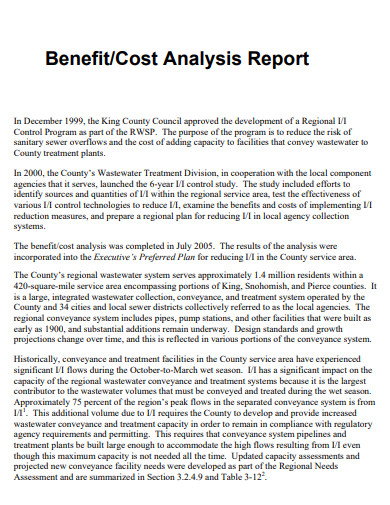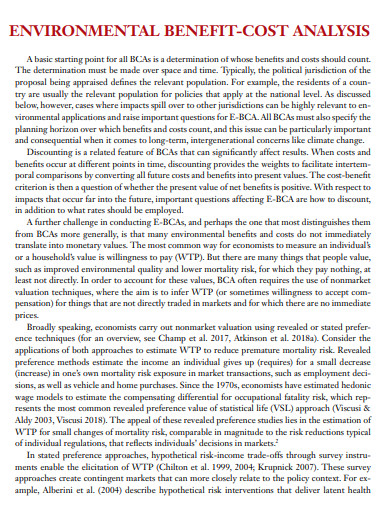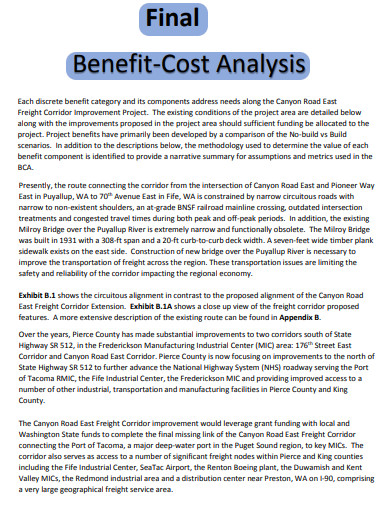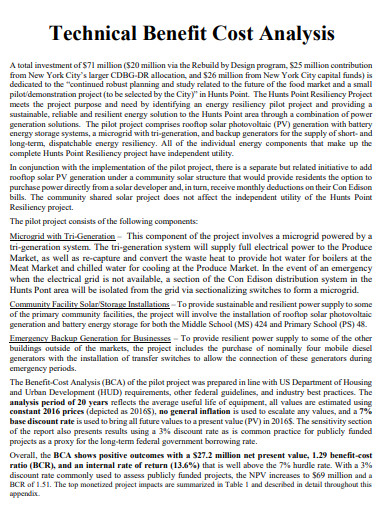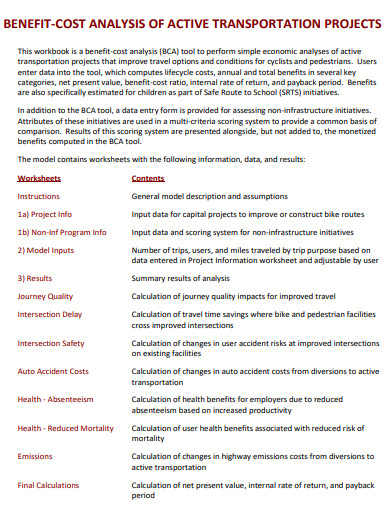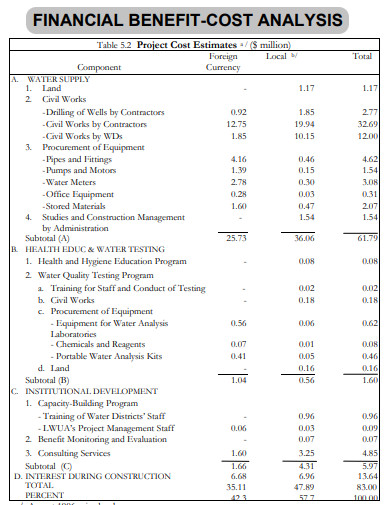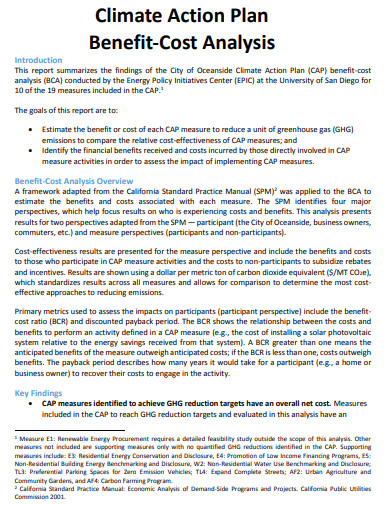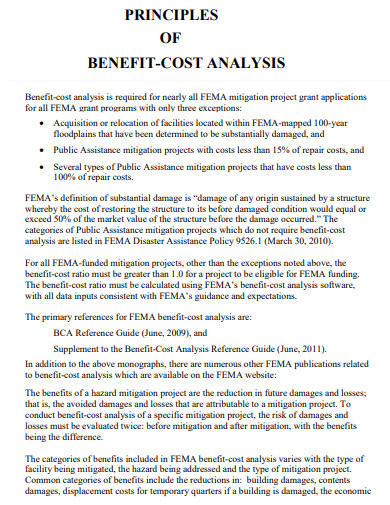Cost-benefit analysis is a process or method used by businesses or companies to evaluate which decision is appropriate to make by comparing the expected price they have to pay for a project against the benefits or opportunities that it will provide in the future. This method basically weighs the advantages and disadvantages or benefits and costs of a project or a decision made to determine its practicality and compare the possible courses of action. Cost-benefit analysis is also helpful in weighing decisions by calculating financial risk and rewards as well as in evaluating new project proposals.
10+ Benefit Costs Analysis Samples
1. Benefit Costs Analysis
2. Understanding Benefit Costs Analysis
3. Supplement to Benefit Costs Analysis
4. Benefit Costs Analysis Report
5. Environmental Benefit Costs Analysis
6. Final Benefit Costs Analysis
7. Technical Benefit Cost Analysis
8. Benefit Cost Analysis of Active Transportation
9. Financial Benefit Cost Analysis
10. Climate Action Plan Benefit-Cost Analysis
11. Principles of Benefit Cost Analysis
What is a Cost Benefit Analysis Template?
A cost-benefit analysis template is a document designed to aid companies and businesses in their decision-making process, making it easier for them to evaluate possible risks and rewards associated with new projects. Project management is a challenging task and an expensive venture which requires companies to make well-measured and informed decisions. By learning the details relevant to a project’s costs and benefits, you can determine the correct objectives, accurate estimation of necessary resources, and the right tools and methods to measure your project’s success or sales performance.
How to Write a Cost-Benefit Analysis?
Performing cost-benefit analysis involves measuring of financial reports or metrics like the revenue generated or costs saved as the outcome of a decision after proceeding with a project. It also includes impalpable benefits and costs or effects from a decision like the morale of the employees and customer satisfaction. This method can also incorporate sensitivity analysis, what-if scenarios, and discounting of cash flow analysis for various options.
Step 1: Determine the Your Project Scope
To start with your cost-benefit analysis, determine your project scope as well as its goals and make a framework to establish this scope. The project scope can be determined by identifying the objectives of the analysis.
Step 2: Determine the Project Costs
The costs of the project can include the direct labor involved in inventory management, raw materials, and manufacturing expenses, indirect costs like electricity, rent, utilities, and labor management, intangible costs such as the impact on customer service, employees’ performance, and delivery times, opportunity costs such as investment deals, and cost of potential risks such as competitions, environmental impacts, and regulatory risks.
Step 3: Identify the Benefits
The benefits of proceeding with a project include higher revenue and sales from increased productivity, intangible benefits such as improved employee health and safety as well as morale and customer satisfaction, and competitive advantages.
Step 4: Compare the Costs and Benefits
Compare your costs and benefits by applying discount rates to identify net present value, using various discount rates, calculating cost-benefit analysis for multiple options, level-setting various options, and performing sensitivity analysis to better understand the impact of small changes in estimates.
FAQs
What is the purpose of performing a cost-benefit analysis?
The main purpose of a cost-benefit analysis is to determine the advantages and disadvantages of participating in a project or task. This method helps companies make informed decisions by collecting necessary information relevant to the costs and benefits of a project proposal. The business management will be able to determine whether the benefits weigh more than the costs before proceeding with the project.
What are the benefits of cost-benefit analysis?
The cost-benefit analysis enables businesses or individuals to evaluate a potential project before making a decision using a data-driven approach, simplifies the decision-making process, and enables them to discover hidden costs and benefits.
What do the inputs and outputs mean in cost-benefit analysis?
The inputs refer to the costs while the outputs refer to the benefits. An example of inputs includes the compensation plan for team members, paid training or software used, and the manufacturing costs while outputs include the production increase, enhanced customer satisfaction, and higher revenue generated.
A cost-benefit analysis template is a tool used for project planning as well as project management which provides businesses, organizations, and companies with the necessary information so they can decide whether to proceed or not with a proposed project. This template includes data on the calculation of cost, benefits, and risks to determine the total value of a project.
Related Posts
FREE 10+ Analysis of Alternatives Samples in PDF
FREE 10+ Failure Mode and Effects Analysis Samples in PDF
FREE 10+ Make or Buy Analysis Samples in PDF
FREE 10+ Fishbone Root Cause Analysis Samples in PDF
FREE 11+ Cost Volume Profit Analysis Samples & Templates in PDF | MS Word
FREE 6+ Corporate Portfolio Analysis Samples in PDF
FREE 10+ Fault Tree Analysis Samples in PDF
FREE 10+ Comp Analysis Samples in PDF
FREE 10+ Fishbone Analysis Samples in PDF
FREE 10+ Individual Swot Analysis Samples in PDF
FREE 10+ 5 Year Analysis Samples in PDF
FREE 10+ Job Hazard Analysis Samples in PDF
FREE 10+ Primary Source Analysis Samples in PDF
FREE 10+ Critical Path Analysis Samples in PDF
FREE 10+ Competition Analysis Samples in PDF

